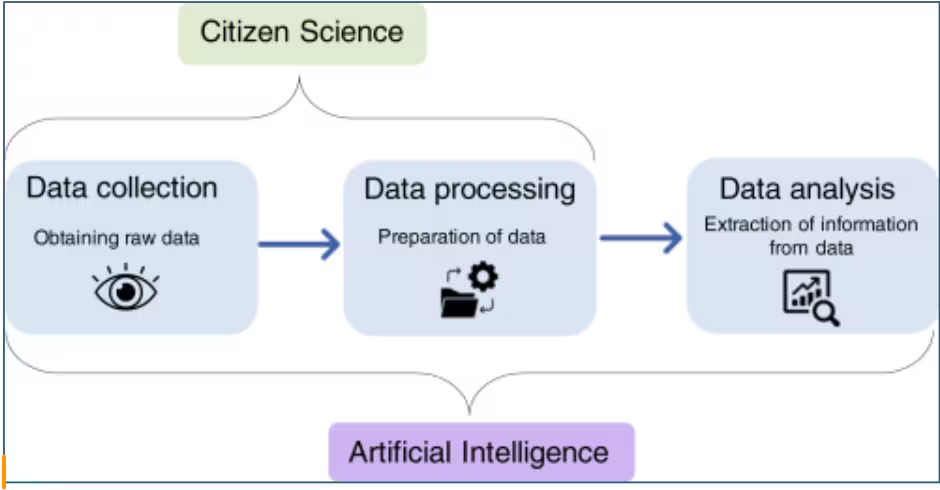Written by: Anurit Kanti and Pratik Kunwar
The rapid acceleration of climate change warrants more than just top-down solutions and expert interventions – it requires communities at the forefront to be equipped with cutting-edge technologies coupled with actionable insights and collaborative tools.
Artificial intelligence (AI), along with citizen science, gives us a unique opportunity to scale, democratize and enhance climate monitoring and action. While citizen science enables data collection and processing in the context of sustainability, AI complements this through effective analysis.
The amalgamation of AI with citizen science holds immense power in addressing sustainability challenges with solutions that bring together data accuracy, predictive analytics, real-time monitoring and integrated environmental intelligence.
The following are three ways AI-powered citizen science can amplify community-led initiatives when it comes to climate monitoring and action.
1. Improving data accuracy and foresight
AI can rapidly process a large quantity of environmental data, which elevates the quality and predictive power of community-sourced data sets. Traditionally, citizen science projects have relied on the manual collection of data and basic statistical tools, which are often constrained by limited resources and data inconsistency. AI can bridge these gaps by automating data cleaning, validating inputs and detecting patterns that are otherwise invisible to the human eye.
For example, WRc (Water Research Centre) teamed up with rainfall data modelling company Rain++ and National Taiwan University to train AI models to spot visual markers of river health using thousands of photographs taken by the Friends of Bradford’s Becks community group. Another example is the River Watchers project, a collaborative project between River Cleanup and VITO (Flemish Institute for Technological Research). Here, citizens take photos of litter and AI helps identify the type of waste and adds it to an interactive map to create a detailed overview of pollution in the area, a valuable resource for cleanup efforts and policymakers.
Similarly, in India, the UNDP Accelerator Lab developed the GeoAI digital platform in collaboration with the University of Nottingham to detect hotspots of air pollution using satellite imagery and AI object detection algorithms. The latter part involved AI algorithms trained by a large group of citizen scientists across the world who volunteered to generate training and validation data for AI algorithms to improve their accuracy. Applying AI algorithms to this citizen science-trained data, more than 47,000 brick kilns across Indo-Gangetic plains of India were detected, enabling regulatory action and pollution mitigation.
These solutions highlight how AI-driven citizen science can move monitoring from reactive observation to proactive management, enabling communities to intervene before environmental issues escalate.

2. Enabling real-time biodiversity and ecosystem monitoring
AI-powered tools are revolutionizing how citizens are increasingly engaging with and monitoring biodiversity. There are, for example, now mobile apps equipped with AI image and sound recognition: iNaturalist, Merlin Bird ID app and Biome app of Japan allow individuals to record and identify species from photographs or audio recordings. This ability to engage in real-time increases the frequency and coverage with which observations of biodiversity are made and enhances the reliability of data by providing immediate feedback and validation.
The Biome app in Japan uses AI algorithms to identify species and enables gamification, where users are rewarded points for submitting recordings and assisting with identification, which inevitably fosters a vibrant community. The app has accumulated over six million biodiversity records since 2019, with community accuracy exceeding 95 percent for birds, mammals, reptiles and amphibians. The data on the app further feeds into conservation planning and supports environmental disclosures for companies.
There are other projects, such as a Finnish app for bird monitoring called ‘Muuttolintujen kevät’ (or MK for short), meaning Spring of Migratory Birds, where bird vocalizations recorded by the app are identified and classified by an AI-backend. Such continual, distributed engagement through citizen science enables communities to produce ecological data in near real-time, which potentially informs conservation and adaptation and potential policy-making too and it does this far more responsively than traditional survey methods.
3. Integrating multi-source data for holistic understanding
AI-powered monitoring systems have the unique ability to synthesize diverse environmental datasets, which include citizen science observations, satellite imagery, sensor outputs and weather models. This ability to integrate provides communities with isolated metrics, along with comprehensive, actionable insights into complex environmental dynamics.
A prominent example of this is Google Earth Engine, a cloud platform that combines big data, AI and machine learning to analyze geospatial and satellite imagery for tracking deforestation, water quality, and urban expansion globally. Communities can upload and integrate their citizen-generated data with remote sensing inputs, which, in turn, facilitates large-scale environmental research, biodiversity assessments and climate change analysis.
Similarly, the Climate Change Initiative of the European Space Agency employs AI processing to classify images and enable rapid detection of deforestation, flooding and urban sprawl. When accessible to communities through open data frameworks, this allows stakeholders to understand and respond to environmental changes in near real-time.
When it comes to water quality monitoring, multi-modal AI models can integrate citizen-collected data with remote sensing systems and hydrological models to foresee contamination events and guide mitigation strategies at the community level.
AI-backed citizen science can be transformative
The convergence of AI and citizen science offers communities transformative tools that collect climate data and aid in interpretation and action with higher precision and impact. With the improvement of data accuracy, enablement of real-time biodiversity monitoring and integration of multi-source datasets, these solutions can facilitate early warnings and inform decision-making and evidence-based advocacy at the grassroots level.
These technologies are no longer experimental; they are proven, scaleable and ready to support communities globally in their climate resilience journeys.
The future of climate monitoring and stewardship depends on leveraging AI to democratize and amplify the voices and actions of citizens, making these local communities a global force for enhancing sustainability. Empowering communities with these AI tools isn’t just a technical upgrade, it is an invitation to participate, innovate and lead in the global climate change movement.
As citizen science and AI evolve simultaneously, they redefine possibilities for all citizens and communities and, most importantly, the planet we all share.
Header Image Credit: Forest S/Unsplash
Republished with permission from World Economic Forum







